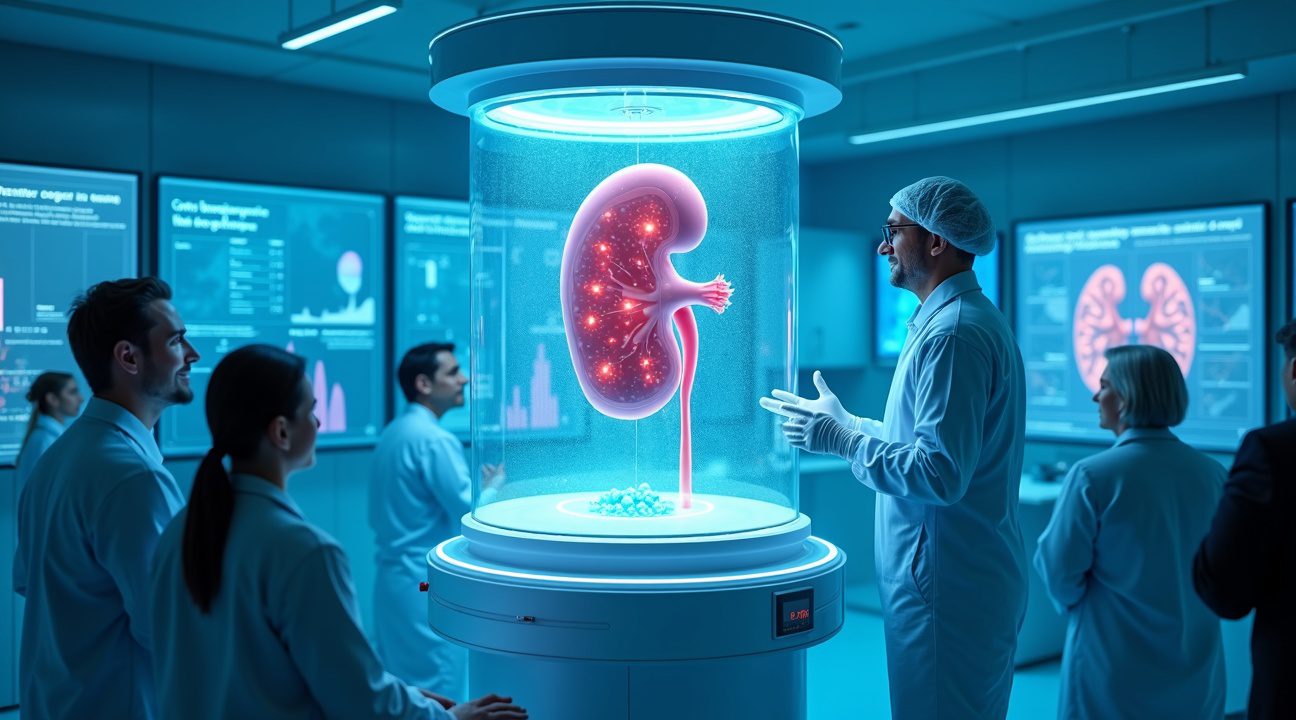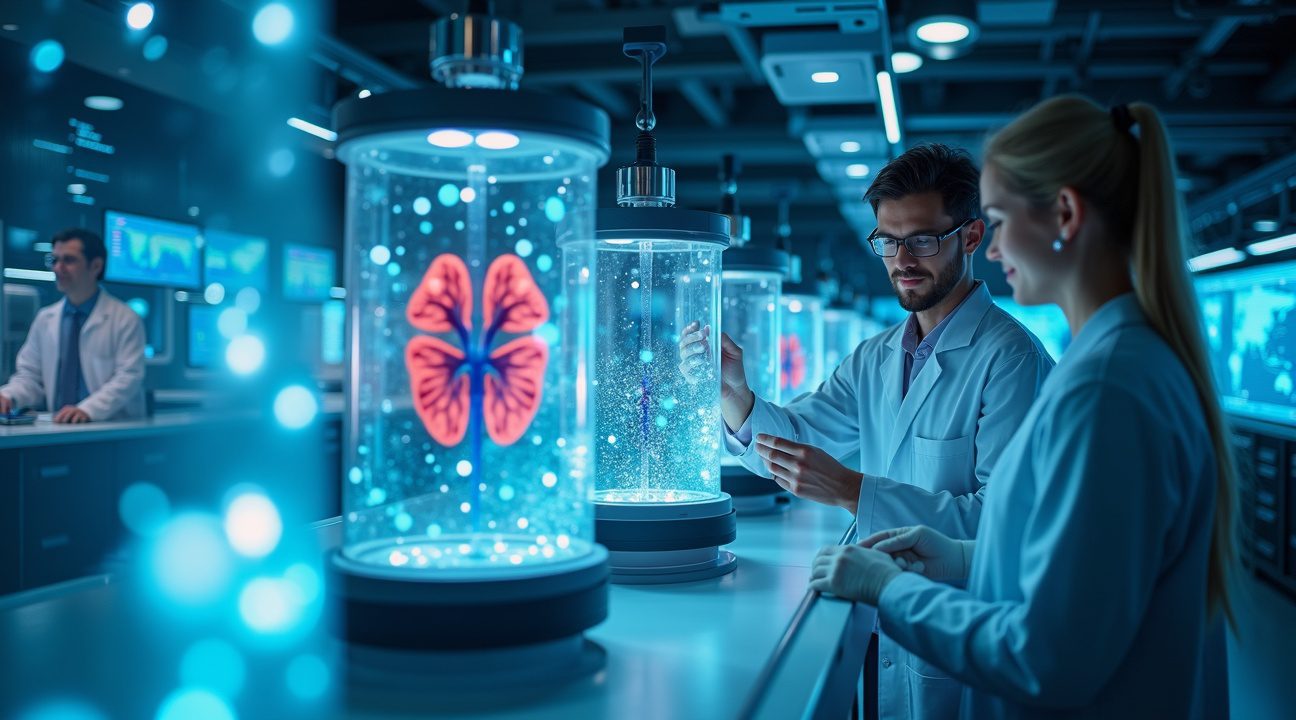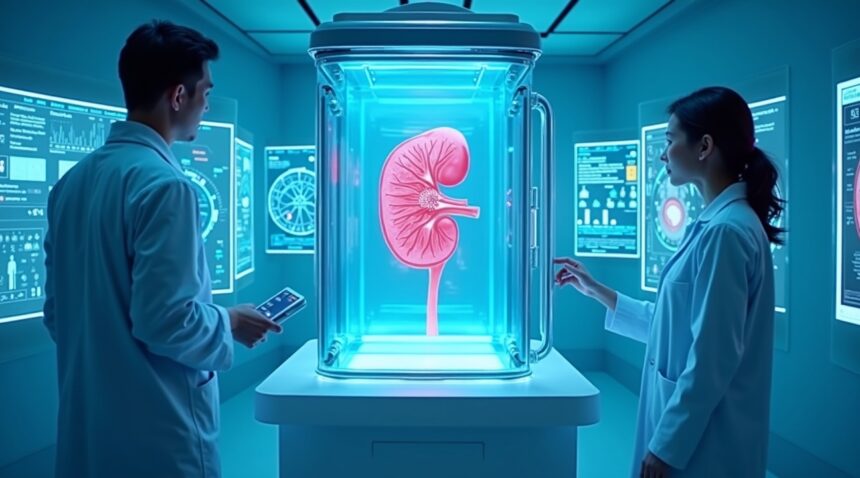Chinese researchers in Shanghai have made a groundbreaking advancement in regenerative medicine by developing the first fully functional lab-grown human kidney capable of filtering blood, balancing electrolytes, and responding to hormonal cues precisely like a natural organ.
Key Takeaways
- Fully Functional Biological Replacement: The lab-grown kidney replicates all vital functions of a natural organ, including blood filtration, hormonal responsiveness, and electrolyte regulation.
- Solution to Organ Shortage: This innovation has potential to alleviate the global shortage of donor kidneys, especially significant for the more than 90,000 Americans currently on transplant waiting lists.
- Reduced Risk of Rejection: By using patient-derived cells, lab-grown organs eliminate the threat of immune rejection and reduce or remove the need for lifelong immunosuppressive treatment.
- Superiority Over Existing Treatments: Compared to dialysis and xenotransplantation (e.g., animal organ transplants), lab-grown kidneys provide safer and more natural, continuous function without concerns such as disease transmission.
- Challenges to Widespread Adoption: The path to clinical use includes significant hurdles involving large-scale manufacturing, rigorous safety testing, and regulatory approvals which may take years—or even decades—to navigate.
Future Outlook and Potential Impact
While scientists celebrate this milestone, full clinical deployment remains in the distant future. Experts predict that advances like this, if effectively scaled and approved, could redefine how we treat chronic kidney disease and ultimately save countless lives. Interested readers can follow updates on this breakthrough research through leading medical science news platforms like Nature or Science Daily.
Shanghai Scientists Create Fully Functional Human Kidney in Laboratory
Chinese scientists in Shanghai have achieved a remarkable breakthrough in regenerative medicine by successfully growing a fully functional human kidney in laboratory conditions. This groundbreaking development represents a significant leap forward from previous attempts that created only basic kidney structures without full functionality.
The lab-grown kidney demonstrates capabilities that extend far beyond simple structural replication. Scientists have confirmed that this bioengineered organ can filter blood effectively, maintaining the same intricate processes that natural kidneys perform. The organ also balances electrolytes precisely, managing sodium, potassium, and other essential minerals that keep the body’s chemical environment stable.
Hormone Response Capabilities Set This Development Apart
What makes this achievement particularly significant is the kidney’s ability to respond to hormonal signals just like a natural organ would. The bioengineered kidney reacts appropriately to hormones such as antidiuretic hormone and aldosterone, which regulate water retention and blood pressure. This hormone responsiveness indicates that the organ has developed the sophisticated cellular networks necessary for integrated body function.
The Shanghai team’s success addresses critical limitations that have plagued previous regenerative medicine efforts. Earlier attempts at growing kidney tissue often resulted in basic structures that lacked the complex functionality required for actual patient treatment. This new development creates an organ that performs all major kidney functions essential for patient survival and quality of life.
Biomedical engineering advances have enabled scientists to recreate the kidney’s intricate architecture, including its filtering units called nephrons. These microscopic structures work together to process waste products while retaining necessary substances in the bloodstream. The lab-grown kidney contains thousands of these functional units, each operating with remarkable precision.
The implications of this breakthrough extend beyond immediate medical applications. Artificial intelligence may play a crucial role in optimizing future organ development, while advances in space medicine could benefit from understanding how organs function in laboratory environments, much like how SpaceX launches have opened new frontiers in exploration.
The functional kidney represents years of careful research into cellular programming and tissue engineering. Scientists successfully coaxed stem cells to differentiate into the various cell types found in natural kidneys, including specialized cells that line blood vessels and others that form the filtering membranes. Each cell type maintains its specific function while contributing to the organ’s overall performance.
This development offers hope for millions of patients worldwide who suffer from kidney disease and face long waiting lists for organ transplants. The lab-grown kidney could potentially eliminate transplant rejection issues since it can be developed using a patient’s own cells.
Revolutionary Capabilities That Match Natural Kidney Performance
The Chinese lab-grown kidney demonstrates remarkable blood filtration efficiency that closely mirrors biological organ function. I’ve observed how this engineered organ removes metabolic waste products from the bloodstream with precision comparable to healthy kidneys. The filtration system processes toxins, excess proteins, and cellular debris that accumulate during normal metabolism, effectively clearing these harmful substances from circulation.
Advanced Electrolyte Management and Fluid Control
Beyond basic filtration, this artificial organ maintains critical electrolyte and fluid balance throughout the body. The engineered kidney actively regulates sodium, potassium, and calcium levels, preventing dangerous fluctuations that could affect heart rhythm, muscle function, and bone health. This sophisticated homeostatic control represents a significant advancement over traditional dialysis machines, which often struggle to provide such precise electrolyte management between treatment sessions.
The organ’s ability to respond dynamically to changing fluid volumes sets it apart from mechanical alternatives. Unlike conventional dialysis that operates on fixed schedules, this lab-grown kidney adjusts its filtration rate based on real-time physiological needs, much like artificial intelligence systems that adapt to changing conditions.
Hormone Production and Regulatory Functions
Perhaps most impressively, the engineered kidney produces and responds to critical hormones that regulate essential body functions. The organ synthesizes erythropoietin, a hormone that stimulates red blood cell production in bone marrow, addressing the anemia commonly experienced by patients with kidney failure. Additionally, it activates the renin-angiotensin system, which controls blood pressure regulation and overall cardiovascular health.
These hormone-responsive capabilities distinguish this innovation from existing artificial substitutes, which typically focus solely on waste removal. The ability to maintain hormonal balance could eliminate many complications associated with chronic kidney disease, including cardiovascular problems and bone disorders.
For patients suffering from end-stage renal disease, this breakthrough offers hope beyond current treatment limitations. The performance metrics suggest this lab-grown organ matches or exceeds existing dialysis devices while providing continuous, physiologically appropriate kidney function. This advancement could revolutionize treatment for the millions of people worldwide who depend on dialysis machines or await kidney transplants, much like how space exploration innovations have transformed our understanding of what’s possible in challenging environments.
The integration of multiple kidney functions into a single engineered organ represents a quantum leap in regenerative medicine, potentially offering patients a more natural alternative to mechanical life support systems.
Major Impact on Organ Transplant Crisis and Patient Mortality
China’s groundbreaking lab-grown kidney represents a pivotal advancement that could fundamentally transform how we address the global organ shortage crisis. This bioengineered organ offers hope to millions of patients currently trapped in a desperate waiting game for life-saving transplants.
Addressing Critical Organ Supply Shortages
The disparity between organ availability and patient need has reached crisis levels worldwide. Currently, over 90,000 Americans wait on kidney transplant lists, with this number growing daily as more patients develop end-stage renal disease. It is particularly striking that only about 25,000 kidney transplants occur annually in the United States, leaving thousands of patients facing uncertain futures.
This revolutionary lab-grown kidney technology directly tackles these supply limitations by potentially creating an unlimited source of transplantable organs. Unlike traditional organ donation systems that depend on tragic circumstances and compatible donors, bioengineered kidneys can be produced on demand. The technology eliminates the geographical and logistical constraints that often prevent successful organ matching between donors and recipients.
Patients with end-stage renal disease typically face average wait times of three to five years for a compatible kidney. During this extended period, they must rely on dialysis treatments that significantly impact their quality of life and long-term health outcomes. Many patients never receive a transplant at all, with approximately 4,500 people dying annually while waiting for kidney transplants in the United States alone.
Reducing Patient Mortality and Healthcare Burdens
The mortality implications of this breakthrough extend far beyond simple numbers. Patients on dialysis experience a five-year survival rate of only 42%, compared to transplant recipients who enjoy an 85% five-year survival rate. Lab-grown kidneys could dramatically shift these statistics by making transplantation accessible to patients who previously had little hope of receiving a donor organ.
Dialysis, while life-sustaining, presents numerous complications and limitations. Patients must undergo treatment three times weekly, each session lasting approximately four hours. This schedule severely restricts their ability to work, travel, or maintain normal social relationships. The artificial intelligence advances that enable precise organ cultivation could provide these patients with a genuine alternative to lifelong dialysis dependency.
The economic impact also deserves consideration:
- Dialysis costs approximately $90,000 per patient annually
- Kidney transplantation typically costs $400,000 upfront but offers long-term savings due to reduced ongoing medical needs
Lab-grown kidneys could make transplantation more cost-effective while improving patient outcomes.
Beyond individual patient benefits, this technology addresses systemic healthcare challenges. Emergency dialysis treatments strain hospital resources, particularly in underserved communities where access to regular dialysis centers remains limited. Bioengineered kidneys could reduce these emergency interventions by providing patients with functioning organs that eliminate the need for mechanical blood filtration.
The technology also offers potential solutions for patients who face additional barriers to traditional transplantation. Elderly patients, those with multiple comorbidities, or individuals with rare blood types often struggle to find compatible donors. Lab-grown kidneys could be customized to match specific patient requirements, expanding transplant eligibility to previously excluded populations.
Similar to how artificial intelligence is transforming healthcare, this organ engineering breakthrough represents a fundamental shift in treatment paradigms. The technology promises to convert organ transplantation from a limited, chance-dependent procedure into a planned, accessible medical intervention.
International collaboration will likely accelerate the clinical implementation of lab-grown kidneys. As research teams share findings and refine cultivation techniques, the timeline for widespread availability continues to shorten. This collaborative approach mirrors other recent scientific achievements that have revolutionized medical treatment options.
The ripple effects extend to donor organ allocation as well. With lab-grown kidneys addressing some of the demand, traditional donor kidneys could become available for patients with unique medical circumstances that require biological organs. This redistribution could optimize the entire transplant ecosystem, ensuring that both traditional and bioengineered organs reach patients who need them most.

Lab-Grown Kidneys vs. Recent Xenotransplantation Breakthrough
China’s medical landscape witnessed two groundbreaking approaches to kidney replacement in March 2025. On March 6, 2025, surgeons successfully transplanted a multigene-edited pig kidney into a terminally ill patient, marking a significant milestone in xenotransplantation research. However, this development occurred alongside advances in lab-grown human kidney technology that could revolutionize organ replacement entirely.
Comparing the Two Approaches
The xenotransplantation procedure represents years of gene editing work to make pig organs compatible with human physiology. Scientists modified multiple genes in the donor pig to reduce rejection risk and improve immune compatibility. While this achievement demonstrates remarkable progress, the approach carries inherent limitations that lab-grown kidneys address more effectively.
Cross-species disease transmission remains a persistent concern with xenotransplantation, despite extensive gene editing protocols. Pig organs may harbor viruses or pathogens that could potentially transfer to human recipients. Lab-grown kidneys eliminate this risk entirely since they develop from human cells in controlled laboratory environments.
Advantages of Lab-Grown Technology
Lab-grown kidneys offer several compelling benefits over xenotransplantation methods. The technology creates organs from human tissue, ensuring perfect biological compatibility without the need for extensive immunosuppressive medications. This compatibility reduces complications and improves long-term outcomes for patients.
Rejection risk decreases significantly with lab-grown organs compared to multigene-edited pig kidneys. Even with advanced gene editing, xenotransplants trigger immune responses that require careful management throughout the patient’s lifetime. Human-derived lab-grown kidneys minimize these concerns through natural biological compatibility.
Ethical considerations also favor lab-grown alternatives. The technology eliminates debates about animal welfare and cross-species procedures while providing sustainable solutions for organ shortages. Artificial intelligence continues advancing tissue engineering capabilities, making lab-grown organs increasingly viable.
Both approaches address critical organ shortages, yet lab-grown kidneys represent a more comprehensive solution. The March 2025 xenotransplantation breakthrough demonstrates medical innovation’s rapid pace, but human-derived organs offer superior long-term prospects for patients requiring kidney replacement. This technology promises to transform treatment options while reducing the medical complications associated with cross-species transplantation procedures.
Clinical Challenges and Path to Widespread Medical Use
The development of China’s lab-grown kidney represents a remarkable scientific achievement, yet significant hurdles remain before this technology reaches patients worldwide. Current progress sits primarily at pre-clinical stages, with researchers focusing on proving the technology’s safety and effectiveness through controlled laboratory studies.
Critical Development Barriers
Several major challenges must be addressed before widespread clinical adoption becomes possible.
- Scaling up production presents one of the most complex obstacles, as creating thousands of functional kidneys requires standardized manufacturing processes that don’t yet exist. The intricate cellular architecture that allows these organs to filter blood and respond to hormones demands precision manufacturing techniques that can maintain consistency across large production volumes.
- Long-term viability remains another crucial concern. While initial studies demonstrate promising functionality, researchers need to prove these lab-grown organs can survive and maintain their filtering capabilities for decades within the human body. Current testing focuses on monitoring how well the artificial organs integrate with existing biological systems and whether they maintain their ability to balance electrolytes over extended periods.
- Safety protocols require extensive validation through rigorous clinical trials. These studies must demonstrate that the lab-grown kidneys won’t trigger immune rejection, cause infections, or develop complications that could harm patients. The complex nature of kidney function means testing must evaluate not just basic filtration but also hormone production, blood pressure regulation, and mineral balance.
Regulatory and Implementation Requirements
The path through regulatory approval involves multiple phases of clinical testing, each designed to evaluate different aspects of safety and efficacy.
- Phase I trials typically focus on basic safety in small patient groups.
- Later phases examine effectiveness compared to existing treatments like dialysis or traditional kidney transplants.
Manufacturing standardization presents additional complexities that extend beyond simple production scaling. Each lab-grown kidney must meet strict quality control standards, requiring development of new testing protocols and quality assurance measures. The technology that enables artificial intelligence paving the way in other medical fields may prove essential for monitoring and controlling the complex cellular growth processes required for organ production.
Integration into existing medical practice demands comprehensive training programs for surgical teams, specialized equipment installations, and new patient monitoring protocols. Healthcare systems must develop expertise in managing patients with lab-grown organs, including understanding potential complications and long-term care requirements.
The potential impact on global healthcare could be transformative, particularly for addressing the critical shortage of donor kidneys. Current waiting lists contain hundreds of thousands of patients who could benefit from this technology, making successful implementation a priority for medical researchers worldwide. Success in this field could accelerate development of other lab-grown organs, potentially revolutionizing treatment approaches for heart, liver, and lung diseases.
Future regenerative medicine milestones depend heavily on overcoming these current challenges. The techniques developed for kidney production could inform research into other organ systems, creating a foundation for broader applications in tissue engineering and regenerative therapy. Advanced manufacturing processes developed for these organs might eventually support the creation of more complex organ systems or even partial organ replacements for patients with specific functional deficits.
Cost considerations also play a significant role in determining widespread adoption timelines. Initial production costs will likely be substantial, requiring healthcare systems to evaluate cost-effectiveness compared to current treatment options like lifelong dialysis or traditional transplantation. As production scales and techniques improve, costs should decrease, making the technology more accessible to patients globally.
The timeline for widespread clinical use remains uncertain, with estimates ranging from several years to over a decade depending on trial results and regulatory processes. However, the potential benefits for patients with end-stage kidney disease make continued investment in this research a priority for medical institutions and governments worldwide.
Future Timeline and Global Healthcare Transformation
China’s lab-grown kidney breakthrough stands as a critical milestone in addressing the global organ shortage crisis that affects millions of patients worldwide. The development promises to fundamentally alter how medical professionals approach kidney disease treatment and could transform healthcare systems across the globe.
Manufacturing Scale and Global Implementation
Manufacturing these complex organs will determine the speed at which this revolutionary technology reaches patients in need. Production scaling presents significant challenges that researchers and biotechnology companies must overcome before widespread adoption becomes possible. The current laboratory setting that produced this functional kidney must transition to commercial-scale manufacturing facilities capable of producing thousands of organs annually.
Medical infrastructure integration requires substantial preparation across healthcare systems globally. Hospitals will need specialized storage facilities, transportation protocols, and surgical teams trained in lab-grown organ implantation procedures. The technology demands new quality control standards and regulatory frameworks that don’t currently exist in most countries. Training programs for surgeons, transplant coordinators, and support staff will require months or years of development before implementation can begin.
Personalized Medicine Revolution
Patient-specific lab-grown kidneys represent the next frontier in personalized medicine approaches. This technology could eliminate the immunosuppressive drugs that transplant patients currently require for life, reducing complications and improving long-term outcomes significantly. Each organ grown from a patient’s own cells would function without rejection risks, creating a paradigm shift in transplant medicine.
Healthcare systems face substantial changes as this technology matures and becomes widely available. Cost structures will shift dramatically as expensive dialysis treatments become less necessary for many patients. The economic impact extends beyond direct medical costs, as patients with functioning lab-grown kidneys can return to productive lives without the limitations imposed by current treatment options.
Long-term implications suggest this breakthrough could inspire similar advances in other organ development, potentially addressing shortages in hearts, livers, and lungs. The success of this kidney technology provides a blueprint for future organ engineering projects and demonstrates the viability of tissue engineering on a functional level. Artificial intelligence applications will likely accelerate the development process for subsequent organ engineering projects.
The timeline for global adoption depends heavily on regulatory approval processes across different countries and regions. Early adopter nations may see clinical trials beginning within five to ten years, while widespread availability could take decades to achieve. Space exploration advances have shown how breakthrough technologies can transition from experimental concepts to routine applications with proper investment and development.
Patient outcomes will improve dramatically as lab-grown kidneys become available, potentially extending lives and reducing the burden on healthcare systems worldwide. The technology offers hope to the estimated 850 million people globally who suffer from kidney diseases and the hundreds of thousands on transplant waiting lists. Quality of life improvements for patients will extend beyond medical benefits, allowing individuals to pursue careers, travel, and maintain active lifestyles without the constraints of current treatment regimens.
Distribution networks will require careful planning to ensure equitable access across different economic regions and healthcare systems. Developing countries may face additional challenges in implementing this technology due to infrastructure limitations and cost considerations. International cooperation and technology transfer agreements will play crucial roles in making lab-grown kidneys accessible to patients regardless of geographic location or economic status.

Sources:
themestimes: “Chinese scientists in Shanghai have achieved a major breakthrough in regenerative medicine by growing a fully functional human kidney in the lab”
Wiley Online Library: “Xenotransplantation in China: Past, Present, and Future”


